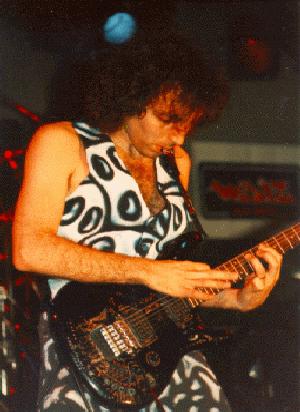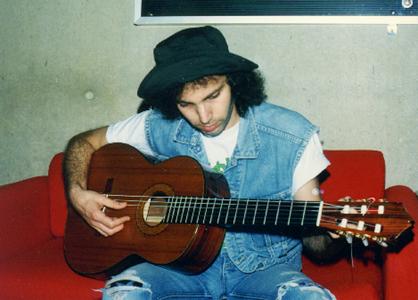|
|
|

As
electronic music hits ever-higher peaks in the current market, the ability to
create music has fallen into the hands of anyone with enough cash for a computer
and sufficient time to learn how to run the latest music software. And as the
scene floods with disk after disk of techno dreck, a question burns quietly
among true music fans: What would happen if an actual musician got his/her hands
on some of this highfalutin' gear? Would they produce a record with a crafty
modernist sensibility and the heart and skill of a bona fide player?
Engines of Creation can be said to mark a startling new phase of creativity
for Joe Satriani, one of the most celebrated and accomplished guitar players
of the last decade. The record is diversely cutting-edge, riddled with musical
riddles and satisfying answers, laced with stunning sonic handiwork and astounding
melodic assaults. At first listen, you may not realize this was a record made
by a guitar player--but once you've heard the guitar, you'll most certainly
know who's playing it.
Yet Engines of Creation also simply represents a new level of sonic achievement
for an artist who has for years been employing electronic textures, severely
altered guitar tones and jump-cut dynamic and compositional gestures. The disk
is as much a snapshot of where that evolution has taken him and his listeners
as it is, only coincidentally, a musical statement which speaks directly to
the current state of electronica, ambient, drum 'n' bass, and hip-hop. Since
the beginning of his recording career, Satriani has been a searching producer
and eccentric composer--one who, only coincidentally, happened to be a monstrously
talented guitarist as well. His first album, a ground-breaking self-titled white-label
job sold out the trunk of his car, was created entirely by altering, re-tuning,
battering and otherwise manipulating the guitar in the pursuit of utterly new
and striking sounds.

And for all its wildness and scope, Engines of Creation is the result of a meticulous
effort to again tap into those artistic areas, rather than simply to superimpose
a batch of virtuoso guitar performances onto modernized rhythm tracks. The burning
"Devil's Slide" is a classic Satriani structure underpinned by forward-thinking
grooves and sinister harmonies, while cuts like "Borg Sex" and "Slow and Easy"
radically morph any idea about what guitar melodies should sound like.
With the exception of portions of the single "Until We Say Good-bye," which
features bass work by noted guitarist Pat Thrall and the drumming of "Late Show
with David Letterman" mainstay Anton Fig under the production eye of Kevin Shirley
(Aerosmith, Black Crowes), all the Engines tracks were recorded by Satriani
and his co-producer Eric Caudieux. Caudieux is best know for his expert digital
editing and programming work alongside legendary producer Trevor Horn (Seal,
Rod Stewart); and for his extensive editing of the recent Guns N' Roses live
anthology. Engines of Creation grew from Satriani's experimental recording sessions
in the wake of his recent band project Crystal Planet. Taking the rare opportunity
to compose at a keyboard in his home studio, and entranced with such recent
music as Crystal Method's Vegas album, the guitarist wrote a group of tunes
which he gradually honed during breaks between tours and collected into malleable
MIDI files.
When enough friends and colleagues heard the material and insisted that he make
the tracks into a proper album rather than an obscure side project, the guitarist
acquiesced and turned to Caudieux for production assistance. Over a period of
several months at a rented house in Laurel Canyon, Engines of Creation emerged
through intensive sessions with nothing on hand but keyboards, guitars, effects
and computers.
The result is a heaping helping of sound collage, jarring leaps and mind-altering
segues, ripped apart by sudden percussive blasts and liquid flurries of notes.
Because of the conveniences afforded by the computer medium, lapses of near-silence
can erupt into passages of huge orchestral splendor or ripping space-guitar,
while synth pads and chugging basslines move in and out of the music seamlessly
It's music equally at home on the dance floor or coming through headphones in
the lava-lamp glow of the smoking room.
Though thoroughly and aggressively rooted in topical tones and modern production,
Engines of Creation recognizes and holds fast to Satriani tradition; "The Power
Cosmic" contains many of the melodic filigrees and displays of warped fretboard
virtuosity that landed the guitarist on magazine covers worldwide, while the
coda of the bluesy "Champagne?" is a solo treatment of suspended chords as popularized
by Keith Richards, the guitarist Satriani temporarily replaced as Mick Jagger's
foil when the Rolling Stones frontman embarked on his first solo tour in 1988.

At that time, Satriani was riding the first peak in his long career, having
just released the instrumental, highly experimental Surfing with the Alien and
watching it ascend the pop charts to eventually sell over two million copies
worldwide. In just a short time, he was a long way from Carle Place, Long Island,
where as a local guitar hero he was visited by a younger schoolmate named Steve
Vai, who showed up at his house with a five-dollar guitar in search of lessons.
After an inspired period of mentoring-- Joe's student roster would soon include
jazz upstart Charlie Hunter, Metallica's Kirk Hammett, Primus' Larry LaLonde
and many others-- Vai returned the favor by getting Satriani signed to his record
label, beginning a whirlwind of global acclaim and a series of gold and platinum
albums, including Flying In A Blue Dream, The Extremist, and Time Machine.
The years since have seen Satriani mount similar challenges and scale new heights:
countless readers' poll awards from magazines, numerous Grammy nominations and
sold-out cross-continental tours. His versatility attracted a recent but politely
declined invitation to join legendary heavy metal pioneers Deep Purple, with
whom he toured in the '90s as a replacement for Ritchie Blackmore. Satriani
also masterminded the phenomenal G3 tours, which brought to renewed worldwide
attention the talents of guitar artists as varied as Steve Vai, Michael Schenker,
Kenny Wayne Shepherd, Robert Fripp, Eric Johnson and many others.
Featuring nothing but computer-generated rhythms, timbres and his six-string,
Engines of Creation is in some respects a throwback to Satriani's first solo
recording, a personal journey through music and sonic mayhem now combined with
a raging artistic desire to harness the technology that's developed so radically
over the intervening decade. It's a complex blend, but remains Satriani, pure
and simple.

Storming onto the music scene nearly a decade ago, Joe Satriani has been widely
recognized as the archetypal post-modern hero. Since his emergence in 1986 with
a self-released, self-titled debut album, Joe has become the most recognizable
guitar voice of his time, earning his place alongside the great masters of rock
guitar. As an instrumental artist in a pop-dominated field, Satriani's accomplishments
are even more remarkable: He is perhaps the most successful rock instrumentalist
in recent history, selling millions of records and consistently packing concert
halls - yet always preserving a strong musical vision, as well as the respect
of fellow musicians and forward-thinking music fans worldwide. Satriani's gift
is creating highly evolved instrumental music, using the structure of popular
standard songs that allows listeners to latch onto tuneful melodies before being
dazzled by his acclaimed musicianship. His hallmarks are a warm, bluesy tone
and delicate phrasing, combined with the bursts of superhuman technical facility
which upped the ante well beyond the standards set by generations of great rock
musicians before him. Satriani's latest disc, Crystal Planet - his first studio
album for Epic Records - reunites the guitarist with G3 Live in Concert producer
Mike Fraser, and finds the artist at a new peak of inspiration. From the pounding
crunch and sizzling harmonics of "Up in the Sky," to the delicate
strains of the solo closer "ZZ's Song," Crystal Planet ranks with
Satriani's most adventurous and accessible discs. Crystal Planet teams Satriani
with bassist Stuart Hamm and drummer Jeff Campitelli, two longtime collaborators
who lend rich support to the album's striking variety of tunes. Satriani unleashes
his heralded sounds and techniques throughout the album, reaching apocalyptic
extremes on the title track and "Time." Typically, his soloing never
disappoints, and on such new pieces as "Trundumbalind" and "With
Jupiter in Mind," he hits new heights of stun-guitar artistry. Tunes like
the moody "A Piece of Liquid" conjure cooler, more subdued atmospheres
which balance the record's intensity. Elsewhere on the album, Satriani revisits
the familiar sound that demanded the attention of millions of pop fans: "A
Train of Angles" creates the joyous pop mood heard in such classic Satriani
radio hits as "Summer Song." On new tunes like "Raspberry Jam
Delta-V," the melodies escalate into passages so stunning, it's difficult
to believe they were performed with just two hands on a single instrument. Joe
Satriani was born in Westbury, New York, and began playing guitar at age 14.
By 1971, he was teaching guitar to others, one of his students being Steve Vai.
In 1974, Joe studied with two modern jazz masters, guitarist Billy Bauer and
pianist/composer Lennie Tristano; four years later, he moved to Berkeley, California,
where he began a 10-year guitar teaching career with students including David
Bryson (Counting Crows), Kirk Hammett (Metallica), Larry LaLonde (Primus), and
Charlie Hunter, among others. In 1984, Joe released a self-titled five-song
EP on his own Rubina label, and the following year completed his first full-length
album Not Of This Earth, which was financed on a credit card and released in
1986 on Relativity Records. In October 1987, Relativity released Satriani's
second album Surfing With The Alien.

The record became a global phenomenon, going platinum with sales of over a million
copies in the U.S. alone and landing Satriani's face on the covers of such magazines
as Guitar Player, Musician, Guitar World, and dozens of other international
publications. Surfing With The Alien was a landmark release which showcased
the guitarist's stunning array of composing, playing , and producing talents.
Consequently and deservedly, it became the most successful instrumental rock
record since Jeff Beck's Wired. Each subsequent Satriani release - including
Flying In A Blue Dream, The Extremist, Time Machine and the recent Joe Satriani,
which was produced by the legendary Glyn Johns - has drawn great commercial
and critical attention. The same seems certain to be the case with Crystal Planet,
and it's not just Joe's fans who have been moved by his unique tone and feel:
Players from all walks of musical life have been attracted to Satriani's work.
After sitting in with Joe's band at New York's Bottom Line, Mick Jagger recruited
Joe in 1988 as lead guitarist for the singer's very first tour apart from the
Rolling Stones. Deep Purple tapped into Satriani's mastery when he assumed lead
guitar position in the band for its 1994 tours of Europe and Japan. In 1996,
the G3 Tour - featuring Joe Satriani, Steve Vai, and Eric Johnson - played 24
dates to some 90,000 fans across North America, a tour documented on the G3
Live In Concert album and home video (both Epic). In 1997, Joe united with jazz
guitar great Pat Martino to record two tracks, "Ellipsis" and "Never
and After," for Martino's acclaimed all-star collection All Sides Now (Blue
Note); and enlisted in a second G3 summer tour, this one co-starring Steve Vai,
Kenny Wayne Shepherd, and Robert Fripp. With its cunning marriage of well-structured
songs, challenging sonic surprises, moody moments and breathtaking guitar playing,
Crystal Planet has all the marks of a great Joe Satriani disc. After a decade
of ground breaking work, this is one musician still willing to push the edge
of conventional rock beyond what's come before.

Joe Satriani Chronology
July 15,1956:
Born in Westbury New York
1970: First picks up the guitar
1971
Teaches guitar for next three years at home in Westbury, Long Island (NY). Steve
Vai is one of his first students.
September
1972:
High School Music teacher Bill Wescott introduces Joe to pitch axis theory.
1974
Self taught for the last four years, Joe takes lessons for three weeks with
Billy Baur in Glen Cove, NY. The same year studies with Lennie Tristano in Queens,
NY, for two months.
1978
Begins a 10-year stint teaching at Second Hand Guitars in Berkeley, CA; students
include David Bryson, Kirk Hammett, Charlie Hunter, Larry Lalonde, Alex Skolnick,
and others.
1979
Forms pop band The Squares in San Francisco with Jeff Campitelli on drums and
Andy Milton on bass.
1984
Releases five-song, EP Joe Satriani on independent label he names after his
wife, Rubina. The album contains guitars exclusively.
1985
Completes the tracks for Not Of This Earth, financing the recording on a credit
card, introduced to Relativity Records by Steve Vai.
September 1986
Tours with pop-rocker Greg Kihn to make ends meet while awaiting a deal-decision
from Relativity.
November 1986
Signed to Relativity Records, Joe is already putting together demos for songs
that will apear on Surfing With The Alien.
October
1987
Surfing With The Alien is released (quickly goes gold and platinum).
February
1988
On the strength of Surfing's reception, Relativity does a second printing of
Not Of This Earth (the initial stock had sold out); because the original artwork
is lost, a new cover adorns the second run. February-March,
September-October 1988:
Interrupts own tour twice to go on road with Mick Jagger.
June 11, 1988
During the Surfing tour three live tracks are recorded for the Dreaming #11
EP (one studio cut-"The Crush Of Love," originally recorded for a Guitar Player
Flexi-disk complete's the package).
November
1988
Dreaming #11 is released (goes gold and fetchs Joe's second Grammy nomination).
October
1989
Flying In A Blue Dream is released (Joe receives third Grammy nomination and
album sells over 750,000 units), and includes Joe's vocals on 6 of it's 18 tracks.
July
1992
Following two intense years of writing and recording, The Extremist is released(immediately
goes gold, debuts at 24 on Billboard and gets yet another Grammy nomination);
it spawns the hit "Summer Song," which is later used in a Sony Walkman Commercial.
October 1993
The double-CD Time Machine is released: Disc One contains studio out-takes and
foreign releases spanning Joe's career, plus four of the five tracks from the
original Joe Satriani EP and three new cuts, Disc Two contains 14 live tracks.
October
1994
Time Machine certified gold, and Joe begins his seventh album.
October 11, 1995
Joe Satriani releases his seventh album, self titled "Joe Satriani", produced
by Glyn Johns. "(You're) My World" was nominated for a Grammy.
October, 1996
The G3 tour, featuring Joe Satriani, Steve Vai, and Eric Johnson, played 24
dates to 90,000 fans in North America. May
1997
G3 featuring Joe Satriani, Steve Vai, and Adrian Legg tours Europe.
June 1997
G3 Live In Concert CD and video released.
June
15, 1997
G3 featuring Joe Satriani, Steve Vai, Kenny Wayne Shephard, and Robert Fripp,
begins U.S. tour.
1998
A new Joe Satriani disk called "Crystal Planet" see the light.
2000
Joe Satriani and Eric Candeaux records Joe's nineth album "Engines of Creation"